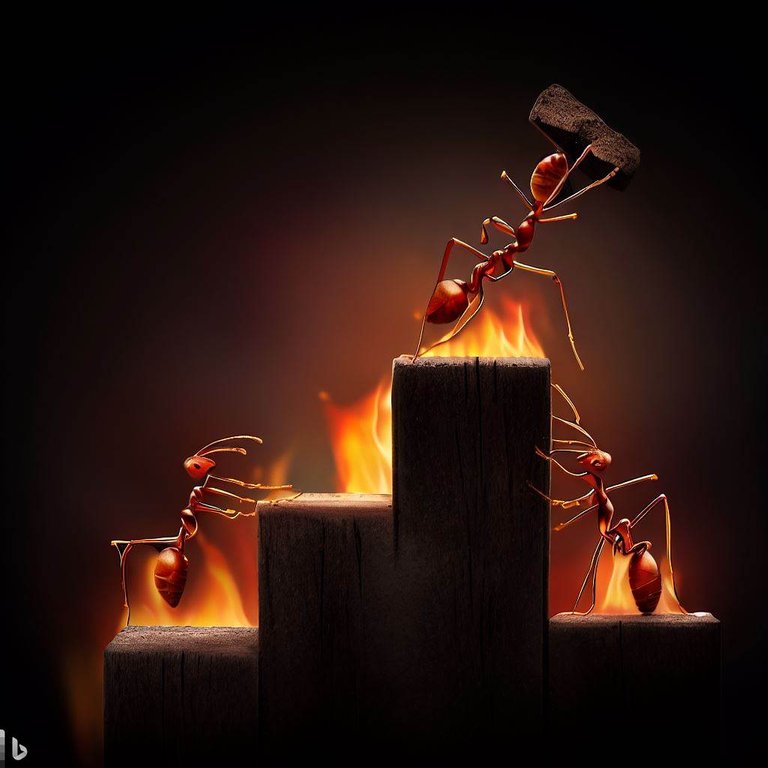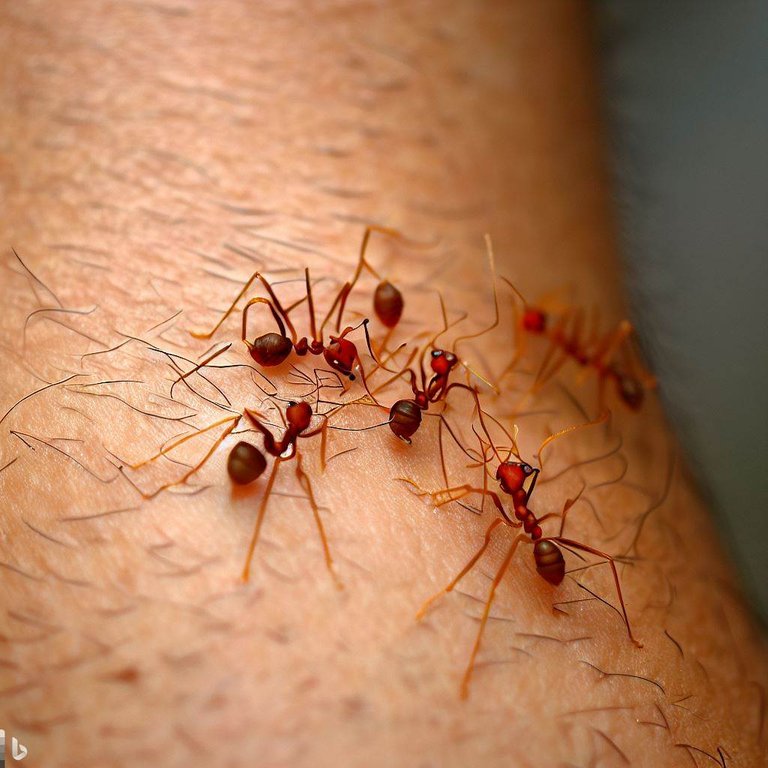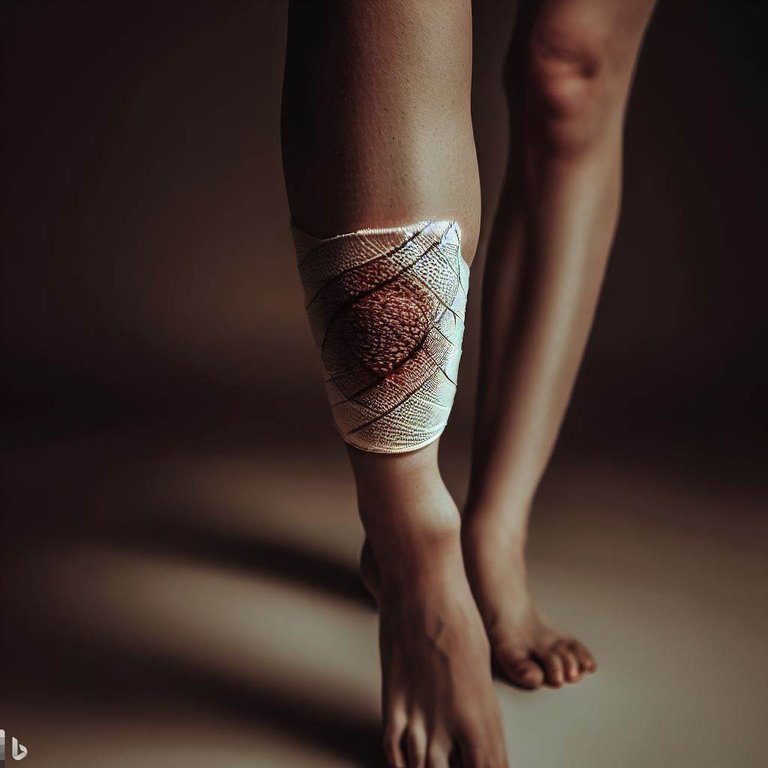The Fire Ant Chronicles
"Hey there! Have you ever had the misfortune of coming into contact with fire ants, those tiny but notorious creatures that seem to have a fiery sting? Well, if you have, you know just how memorable their bites can be. Fire ant bites can unleash a series of uncomfortable and sometimes painful stages that can leave you scratching and wondering when it will all be over.
To better prepare you to handle and treat fire ant bites, this article will delve into the fascinating world of fire ant bites and explore the various stages they go through. It is fascinating to see how a seemingly harmless encounter with these ants can escalate into a multi-step journey of sensations and reactions.
So, if you're up for it, let's go into the riveting phases of fire ant bites, beginning with the initial contact and ending with the healing and recuperation.
The First Step: Making Contact
Let's discuss your initial experience with fire ants. Imagine this: you're going about your day as usual when, out of nowhere, you step into a mound of fire ants. And with that, you've established contact. Start the suspense!
As soon as your bare foot or hand touches the ant mound, you'll know you're in for a surprise. Those cheeky varmints don't spare any time establishing territory. You will begin to feel the consequences of their rage in a matter of seconds.
It may start off as a little prick or sting, just enough to get your attention. But believe me, that's only the start. Some fairly unpleasant feelings will begin shortly after the initial encounter. You'll probably notice a reddening of the bitten site and the beginnings of an itchy rash. Your body is basically trying to tell you, "Uh oh, something's not right here."
The catch is that fire ants don't work alone. They're not harmless social butterflies, sir. If you find one fire ant mound, it's likely that there's a whole colony in the area. And they don't hold back when they bite. So, while that first interaction could appear innocuous, you should actually brace yourself for what's to follow.
The first phase focuses on the experiences gained through the first interaction. It's a sign that things are going to get serious. Be wary about making direct contact with a fire ant mound the next time you come across one. Though seemingly little, that's just the beginning of the problems associated with fire ant bites. Don't miss out on the rest of the narrative of fire ant bites as we continue through the succeeding stages!"
Stage 2: Immediate Reaction
Let's move on to the second act of the fire ant bite drama, the instant reaction, so strap in because it's about to become sizzling hot!
A bite from a fire ant is like having a switch flipped: as soon as the ants' tiny teeth penetrate your skin, you'll start experiencing the consequences practically instantly.
The majority of people report a burning feeling right away. This is no ordinary burn; rather, it's like putting your hand into a bowl of hot chili peppers. Your skin will feel like it's on fire, and the experience can range from slightly unpleasant to excruciatingly painful.
But that's not all; swelling is also characteristic of the initial phase of a reaction to a bite. The region around the bite will swell up like a balloon, making it impossible to ignore. The degree of swelling depends on a variety of variables, including the number of bites and the victim's susceptibility to fire ant venom.
Now, let's not overlook the itching. Oh boy, the itching! It's like an insatiable desire to scratch that won't go away, as if your body received a note from the fire ants that read, "Hey, let's make this even more unpleasant! Scratching may help temporarily, but it can actually cause more discomfort and even damage the skin, which can lead to more issues.
The initial phase of a fire ant bite reaction can last anywhere from a few minutes to a couple of hours, depending on the individual and the intensity of the bites. This is a trying time, to be sure, but we're just getting started on this roller coaster.
Expect a burning sensation, swelling, and an uncontrollable itch when those fire ants sink their fiery fangs into you. It's a fierce battle between your body and those tiny but mighty insects. But don't worry; we'll get through the subsequent stages and find ways to soothe those immediate reactions.
Pustule Formation Marks the Third Stage
Pustule formation marks the beginning of Act III of the fire ant bite tale. Get ready for a whole new level of agony, because here we go.
So you made it through the initial encounter and the intense initial reaction unscathed. Pustules packed with fluid are the subject of the following section: Oh, joy!
Those bites that didn't seem so bad at first eventually turn into something far worse. Small, raised lumps begin to appear at the bite areas. Pustules, small fluid-filled sacs, emerge as your body reacts to the fire ant venom, so they aren't simply regular bumps.
These pustules aren't cosmetic any longer. Nope, they bring their own set of feelings with them. They may offer a pleasant sting by being delicate to the touch. As they draw attention to themselves with every step or inadvertent touch against an object, you may discover that you are acutely aware of their existence.
But here's the rub: Stage 2 itching? It doesn't just vanish into thin air. No, it lingers on like an uninvited visitor at a celebration. In fact, as the pustules grow, the itchiness may become more severe. The fact that the fire ants were so harsh on your skin is constantly brought to mind.
Moreover, there is the matter of presentation. These pustules can range in size and appearance from tiny and transparent to huge and cloudy. Each one seems to have its own character, with its own unique account of the struggle your body went through to rid itself of those pesky fire ants.
Now, a word of caution: don't pick at those pimples. The chance of infection and the length of time it takes to recover are both increased if you break them open, which is easier said than done. It's better to just let the pustules heal themselves naturally.
In the following phase, events will take a surprising turn, so stay tuned. Be patient while you cope with these pustules and try to control your irritation.
Stage 4: The Pustule Bursts and a Crust Forms
The pustules have decided it's time to explode, so let's move on to Stage 4 of the fire ant-biting journey. It's going to become a little chaotic, so brace yourself.
Remember those pustules packed with fluid from the previous phase? Well, they're at the end of their tether now. Some of the pustules will spontaneously burst when the inflammation diminishes and they reach maturity. It's like being hit in the face with a mini-explosion of disgusting fluid.
The murky fluid contained within these pustules is released upon rupture. Even if it stinks, it's a necessary step in getting better. The fluid is harmless and not infectious, so there's no need to worry. It's merely the leftovers of the fire ant poison and your body's immunological response.
The bite location is undergoing yet another metamorphosis when the fluid is expelled. The pustules that have broken open develop a crust or scab. It's the body's natural method of shielding the mending skin underneath. The crust may be somewhat higher than the surrounding skin, rougher, or a little different color. This is a very natural and necessary part of the recovery process.
It's possible that your itching and pain will subside during this phase. When the pustules finally rupture, it might feel like a weight has been lifted off your shoulders. Like your body is saying, "Okay, we're making progress here."
Do not, under any circumstances, pick at the crust or scab. If you're the kind that enjoys peeling things (no judgment here), I totally see how difficult it is to resist the temptation. It may be tempting to pick at the scab and speed up the healing process, but doing so can actually increase the risk of infection and even result in scarring.
You should wait for the crust to fall off your skin on its own. It means the skin beneath has been repaired and rejuvenated. Let time pass, and your body will heal itself.
Phase 5: Recuperation and Healing
Healing and restoration, at last: After the initial encounter, the subsequent response, the pustule growth, and the pustule rupture, your skin will finally have a chance to recover and return to its normal state. Relax, because we're about to enter the thrilling conclusion to our fire-ant-biting escapade.
The healing process accelerates as the crusts or scabs developed in the preceding stage begin to weaken and fall off. Your skin's natural healing processes kick in, and your body's miraculous regeneration abilities do their thing.
At this point, your symptoms should have significantly improved. There is a gradual reduction in the burning feeling, itching, and swelling. It's a welcome relief after all the stress and pain you've been going through.
Now, the time it takes to recuperate and get back on your feet might vary widely from one individual to the next. The extent of the damage, your body's ability to recover, and how well you've taken care of the damaged areas are all considerations. The time it takes for the skin to totally recover might vary from a few days to a couple of weeks.
The importance of good wound care cannot be overstated at this point. The healing process can be sped up and infections avoided by keeping the afflicted regions clean and dry. Mild soap and water can be used to clean the area, and ointments or creams can be applied if prescribed by a doctor to speed healing and alleviate pain.
The crusts or scabs may peel off, and new, pinkish skin may become visible as the healing process continues. It means your body has finished fixing the problems caused by the fire ant bites.
Now, keep in mind that even though the physical symptoms of the bites have healed, the memory of the encounter may persist. Mild scarring or hyperpigmentation at the bite sites has been seen in a small percentage of people. However, with time, these tend to diminish in intensity.
Care and Preventative Measures
The best way to deal with a fire ant bite and prevent other bites is to seek prompt medical attention. In section, we will examine these factors briefly yet thoroughly.
There are several options available for therapy. OTC topical lotions and ointments containing chemicals like hydrocortisone or antihistamines can help relieve itching and irritation in moderate instances. Some people also find comfort in using cold compresses or taking antihistamines orally.
However, it is important to visit a doctor if you develop a severe response or symptoms of infection such as worsening discomfort, pus, or redness. In severe cases, doctors may consider oral antibiotics, corticosteroid injections, or harsher topical medicines.
Let's switch gears and talk about how to keep from getting bit by fire ants in the first place. Here are some ways to combat those annoying ants:
Keep an eye out for fire ant mounds while you're outside, especially in sandy or grassy places. Avoid running into them by keeping your distance.
Put on some long sleeves, some long pants, some closed-toe shoes, and some socks before you go exploring in fire ant land. When worn together, trousers and socks provide a protective barrier.
As a secondary measure against fire ants, you can use insect repellents containing DEET or picaridin to cover any exposed skin or clothes.
In the unfortunate event that you accidentally disrupt a fire ant mound, try to stay cool and carefully walk away from the area. When you move rapidly, you risk angering the ants and getting bitten.
Read up on fire ants, where they like to live, and how they behave to better inform yourself and others. Help your loved ones stay safe by sharing this information with them.
The possibility of discomfort and consequences from fire ant bites can be greatly reduced by taking these precautions.
Remember that prevention and therapy are two sides of the same coin. Use effective treatments for fire ant bites as soon as possible, and take precautions to avoid further exposure if possible. Keep your wits about you and your gear handy, and you may spend more time outside without worrying about scorching bites.
Listen to the final verdict.
As we conclude our tour through the effects of a fire ant bite, we learn that these seemingly harmless insects have a lot of power. We have examined the progression from initial exposure to subsequent responses, the formation of pustules, their final rupture, and the succeeding phases of healing and recovery. A lot of pain, itchiness, and messiness have come along with the voyage.
You may now face future interactions with fire ants with confidence thanks to your newfound understanding of these stages. Keep in mind that the best defense is a good offense; maintain vigilance, remain alert, and take precautions. Seek medical attention immediately if bitten, since this will help alleviate pain and prevent further consequences.
Although fire ant bites are painful and leave a visible scar, they also teach us to appreciate the incredible resilience of the human body. The changes our skin goes through as we age are a constant reminder of its resilience.
Therefore, I hope this essay has shed light on the fascinating history of fire ant bites, whether you've experienced them directly or are merely equipping yourself with knowledge.
References





Dear @jsalvage !
Are fire ants dangerous insects that kill people in Nigeria?
Where I live, fire ants are not dangerous.
I am more afraid of wasps than fire ants! 😃
Thanks for your contribution to the STEMsocial community. Feel free to join us on discord to get to know the rest of us!
Please consider delegating to the @stemsocial account (85% of the curation rewards are returned).
You may also include @stemsocial as a beneficiary of the rewards of this post to get a stronger support.